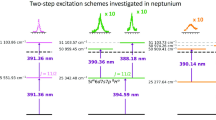Abstract
THE so-called ammonia band at 3360–70 A., photographed first by Eder in 1892, has since been studied and measured by many authors. Fowler and Gregory (Phil. Trans. Roy. Soc., 218, 351; 1919) have published beautiful photographs of it. Lately this band has been attributed by Barrat (Proc. Roy. Soc., A, 98, 40; 1920), Hulthen and Nakamura (NATURE, 119, 235; 1927), and others to the NH molecule. Using R. W. Wood's arrangement for the optical excitation of mercury vapour (Phil. Mag., Oct. 1925, Sept. 1927), I have observed the appearance of it when about 4 mm. nitrogen and very little hydrogen—perhaps a few thousands of mm.—are admitted to the quartz tube containing the mercury vapour which is being excited by the light of a water-cooled, magnetically deflected mercury arc.
Similar content being viewed by others
Author information
Authors and Affiliations
Rights and permissions
About this article
Cite this article
GAVIOLA, E. The NH Band and the Dissociation Energy of Nitrogen. Nature 122, 313–314 (1928). https://doi.org/10.1038/122313b0
Issue Date:
DOI: https://doi.org/10.1038/122313b0
- Springer Nature Limited





